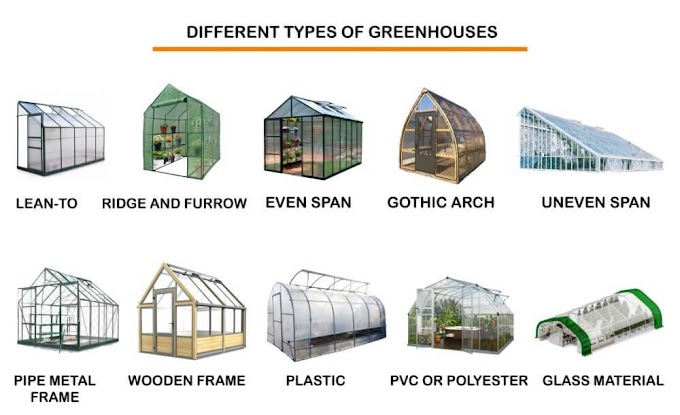Green House
Greenhouse is the most practical method of achieving the objectives of protected agriculture, where the natural environment is modified by using sound engineering principles to achieve optimum plant growth and yields
Green House:
A greenhouse is a framed or an inflated structure covered with a transparent or translucent material in which crops could be grown under the conditions of at least partially controlled environment and which is large enough to permit persons to work within it to carry out cultural operations.
The growing of off - season cucumbers under transparent stone for Emperor Tiberius in the 1st century, is the earliest reported protected agriculture. The technology was rarely employed during the next 1500 years. In the 16th century, glass lanterns, bell jars and hot beds covered with glass were used to protect horticultural crops against cold. In the 17th century, low portable wooden frames covered with an oiled translucent paper were used to warm the plant environment.
In Japan, primitive methods using oil -paper and straw mats to protect crops from the severe natural environment were used as long ago the early 1960s. Greenhouses in France and England during the same century were heated by manure and covered with glass panes. The first greenhouse in the 1700s used glass on one side only as a sloping roof. Later in the century, glass was used on both sides. Glasshouses were used for fruit crops such as melons, grapes, peaches and strawberries, and rarely for vegetable production.
Protected agriculture was fully established with the introduction of polyethylene after the World war II. The first use of polyethylene as a greenhouse cover was in 1948, when professor Emery Myers Emmert, at the University of Kentucky, used the less expensive material in place of more expensive glass
The total area of glasshouses in the world (1987) was estimated to be 30,000 ha and most of these were found in North- Western Europe. In contrast to glasshouses, more than half of the world area of plastic green houses is in Asia, in which China has the largest area.
According to 1999 estimates, an area of 6, 82,050 ha were under plastic greenhouses. In most of the countries, green houses are made of plastic and glass; the majority is plastic.
Glasshouses and rigid plastic houses are longer-life structures, and therefore are most located in cold regions where these structures can be used throughout the year. In Japan, year round use of greenhouses is becoming predominant, but in moderate and warm climate regions, they are still provisional and are only used in winter
In India, the cultivation in the plastic greenhouses is of recent origin. As per 1994-95 estimates, approximately 100 ha of India are under greenhouse cultivation
Since 1960, the greenhouse has evolved into more than a plant protector. It is now better understood as a system of controlled environment agriculture (CEA), with precise control of air and root temperature, water, humidity, plant nutrition, carbon dioxide and light. The greenhouses of today can be considered as plant or vegetable factories. Almost every aspect of the production system is automated, with the artificial environment and growing system under nearly total computer control
Greenhouse Effect:
In general, the percentage of carbon dioxide in the atmosphere is 0.035% (345 ppm). But, due to the emission of pollutants and exhaust gases into the atmosphere, the percentage of carbon dioxide increases which forms a blanket in the outer atmosphere. This causes the entrapping of the reflected solar radiation from the earth surface. Due to this, the atmospheric temperature increases, causing global warming, melting of ice caps and rise in the ocean levels which result in the submergence of coastal lines. This phenomenon of increase in the ambient temperature, due to the formation of the blanket of carbon dioxide is known as greenhouse effect
The greenhouse covering material acts in a similar way, as it is transparent to shorter wave radiation and opaque to long wave radiation
During the daytime, the shorter wave radiation enters into the greenhouse and gets reflected from the ground surface. This reflected radiation becomes long wave radiation and is entrapped inside the greenhouse by the covering material. This causes the increase in the greenhouse temperature. It is desirable effect from point of view of crop growth in the cold regions
Advantages of Greenhouses:
The following are the different advantages of using the green house for growing crops under controlled environment:
1. Throughout the year four to five crops can be grown in a green house due to availability of required plant environmental conditions.
2. The productivity of the crop is increased considerably.
3. Superior quality produce can be obtained as they are grown under suitably controlled environment.
4. Gadgets for efficient use of various inputs like water, fertilizers, seeds and plant protection chemicals can be well maintained in a green house.
5. Effective control of pests and diseases is possible as the growing area is enclosed.
6. Percentage of germination of seeds is high in greenhouses.
7. The acclimatization of plantlets of tissue culture technique can be carried out in a green house.
8. Agricultural and horticultural crop production schedules can be planned to take advantage of the market needs.
9. Different types of growing medium like peat mass, vermiculate, rice hulls and compost that are used in intensive agriculture can be effectively utilized in the greenhouse.
10. Export quality produce of international standards can be produced in a green house.
11. When the crops are not grown, drying and related operations of the harvested produce can be taken up utilizing the entrapped heat.
12. Greenhouses are suitable for automation of irrigation, application of other inputs and environmental controls by using computers and artificial intelligence techniques.
13. Self-employment for educated youth







No comments:
Post a Comment